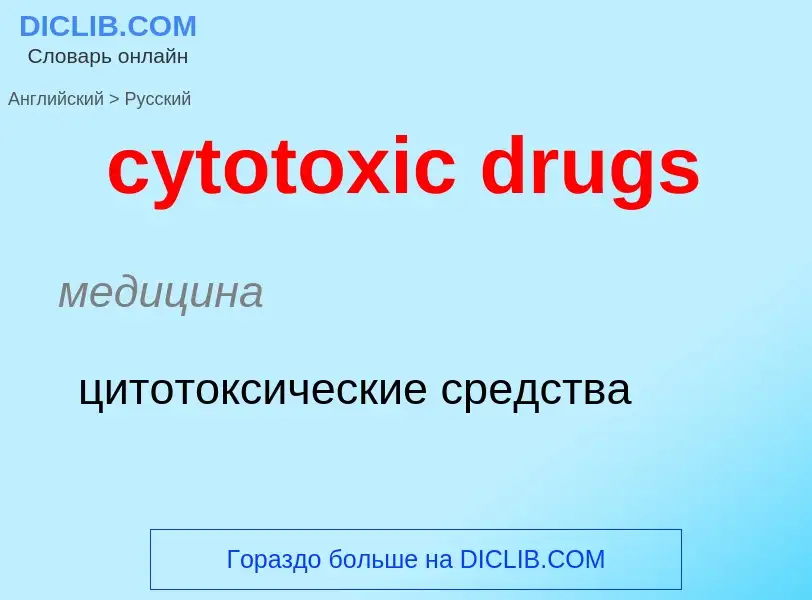Tradução e análise de palavras por inteligência artificial ChatGPT
Nesta página você pode obter uma análise detalhada de uma palavra ou frase, produzida usando a melhor tecnologia de inteligência artificial até o momento:
- como a palavra é usada
- frequência de uso
- é usado com mais frequência na fala oral ou escrita
- opções de tradução de palavras
- exemplos de uso (várias frases com tradução)
- etimologia
cytotoxic drugs - tradução para russo
медицина
цитотоксические средства
общая лексика
цитотоксический T-лимфоцит
медицина
цитотоксический Т-лимфоцит
Definição
Wikipédia

Chemotherapy (often abbreviated to chemo and sometimes CTX or CTx) is a type of cancer treatment that uses one or more anti-cancer drugs (chemotherapeutic agents or alkylating agents) as part of a standardized chemotherapy regimen. Chemotherapy may be given with a curative intent (which almost always involves combinations of drugs) or it may aim to prolong life or to reduce symptoms (palliative chemotherapy). Chemotherapy is one of the major categories of the medical discipline specifically devoted to pharmacotherapy for cancer, which is called medical oncology.
The term chemotherapy has come to connote non-specific usage of intracellular poisons to inhibit mitosis (cell division) or induce DNA damage, which is why inhibition of DNA repair can augment chemotherapy. The connotation of the word chemotherapy excludes more selective agents that block extracellular signals (signal transduction). The development of therapies with specific molecular or genetic targets, which inhibit growth-promoting signals from classic endocrine hormones (primarily estrogens for breast cancer and androgens for prostate cancer) are now called hormonal therapies. By contrast, other inhibitions of growth-signals like those associated with receptor tyrosine kinases are referred to as targeted therapy.
Importantly, the use of drugs (whether chemotherapy, hormonal therapy or targeted therapy) constitutes systemic therapy for cancer in that they are introduced into the blood stream and are therefore in principle able to address cancer at any anatomic location in the body. Systemic therapy is often used in conjunction with other modalities that constitute local therapy (i.e., treatments whose efficacy is confined to the anatomic area where they are applied) for cancer such as radiation therapy, surgery or hyperthermia therapy.
Traditional chemotherapeutic agents are cytotoxic by means of interfering with cell division (mitosis) but cancer cells vary widely in their susceptibility to these agents. To a large extent, chemotherapy can be thought of as a way to damage or stress cells, which may then lead to cell death if apoptosis is initiated. Many of the side effects of chemotherapy can be traced to damage to normal cells that divide rapidly and are thus sensitive to anti-mitotic drugs: cells in the bone marrow, digestive tract and hair follicles. This results in the most common side-effects of chemotherapy: myelosuppression (decreased production of blood cells, hence also immunosuppression), mucositis (inflammation of the lining of the digestive tract), and alopecia (hair loss). Because of the effect on immune cells (especially lymphocytes), chemotherapy drugs often find use in a host of diseases that result from harmful overactivity of the immune system against self (so-called autoimmunity). These include rheumatoid arthritis, systemic lupus erythematosus, multiple sclerosis, vasculitis and many others.





![[[Deoxycytidine]] (left) and two anti-metabolite drugs (center and right), [[gemcitabine]] and [[decitabine]]. The drugs are very similar but they have subtle differences in their [[chemical structure]]. [[Deoxycytidine]] (left) and two anti-metabolite drugs (center and right), [[gemcitabine]] and [[decitabine]]. The drugs are very similar but they have subtle differences in their [[chemical structure]].](https://commons.wikimedia.org/wiki/Special:FilePath/Deoxcytidine, Gemcitidine and Decitabine.png?width=200)

![[[Scanning electron micrograph]] of [[mesoporous silica]], a type of [[nanoparticle]] used in the delivery of chemotherapeutic drugs [[Scanning electron micrograph]] of [[mesoporous silica]], a type of [[nanoparticle]] used in the delivery of chemotherapeutic drugs](https://commons.wikimedia.org/wiki/Special:FilePath/Mesoporous silica SEM.jpg?width=200)

![Two girls with [[acute lymphoblastic leukemia]] receiving chemotherapy. The girl on the left has a [[central venous catheter]] inserted in her neck. The girl on the right has a [[peripheral venous catheter]]. The arm board stabilizes the arm during needle insertion. Anti-cancer IV drip is seen at top right. Two girls with [[acute lymphoblastic leukemia]] receiving chemotherapy. The girl on the left has a [[central venous catheter]] inserted in her neck. The girl on the right has a [[peripheral venous catheter]]. The arm board stabilizes the arm during needle insertion. Anti-cancer IV drip is seen at top right.](https://commons.wikimedia.org/wiki/Special:FilePath/Pediatric patients receiving chemotherapy.jpg?width=200)
![[[Sidney Farber]] did pioneering work in chemotherapy. [[Sidney Farber]] did pioneering work in chemotherapy.](https://commons.wikimedia.org/wiki/Special:FilePath/Sidney Farber nci-vol-1926-300.jpg?width=200)


